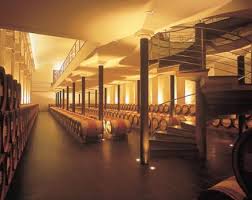Pavie is
derived from the word pavies, which refers to the deeply colored peaches that
once grew on the site. The estate once belonged to four separate owners, with the
Talleman family having the most significant portion and producing the greatest quantity
of wine. It was followed by the Pigasse family who also owned Larcis, and two
other gentlemen called Lafleur and Chapuis.
The
Pigasse portion contracted as the years passed, and with the death of Adolphe
Pigasse in 1868, his widow sold off a number of the plots. On the other hand,
during the same period, the Fayard-Talleman family had expanded the properties
and came to own the majority of the estate.
But the
current estate really came about when Ferdinand Bouffard arrived, acquiring not
just the Fayard-Talleman vineyard but also the small area still under Pigasse as
well as other plots from local families. These were managed separately, with
the Pigasse portion becoming the today Pavie-Decesse, and the portion from
Chapuis becoming today’s Pavie-Macquin.
Ferdinand
invested wisely to eradicate unsuitable varieties, refurbish the cellar and
fight against phylloxera. He later sold the estate to Albert Porte in 1918, and
was subsequently sold again to Alexandre Valette, who also owned
Troplong-Mondot, in 1943.
 With his
death, the vineyard at Troplong-Mondat was passed to his grandson Claude, and
then the next generation Christine, with Alexandre’s other grandson Jean-Paul
taking over Pavie. There are certain critics who rated the wines of the Valette
era very highly, whereas others like Robert Parker who did not think so.
With his
death, the vineyard at Troplong-Mondat was passed to his grandson Claude, and
then the next generation Christine, with Alexandre’s other grandson Jean-Paul
taking over Pavie. There are certain critics who rated the wines of the Valette
era very highly, whereas others like Robert Parker who did not think so.
The
modern history of Pavie is associated with Gerard Perse, a supermarket magnate,
who acquired Monbousquet in 1993, Pavie-Decesse in 1997, and then in 1998 Pavie
itself. Perse began the construction of a new cellar, with new wooden
fermentation vats having temperature control, to replace the concrete vats. A radical
restoration of the chateau also was carried out, with extensive uprooting of
vines and replanting.
The
vineyards now cover 37 ha, located to the southeast of St-Emilion, with
limestone at the top, clay and limestone on the slope, and alluvial gravel sandy
soils at the bottom. The vines average over 40 years, with 60% Merlot, 30%
Cabernet Franc and 10% Cabernet Sauvignon. Future plantings will focus on the
Cabernets instead of Merlot.
In 2001
Pavie absorbed vines from the neighboring La Clusiere (2.5 ha) as well as 9 ha
from Pavie-Decesse, in the process also declassifying 6 ha on the lower slopes
to bolster quality. The vines are trained high to improve exposure of the
fruit, with leaf thinning and green harvesting.
Manually
harvested, the yield is low at 30 hl/ha, with sorting before transporting to
the top of vat-room by conveyor. The vines are fermented plot by plot in temperature-controlled
oak vats with a short maceration, before malolactic fermentation for up to 24
months in nearly 100% new oak.
The
wines will undergo batonnage, the stirring of lees to enrich the wines, and this
was not commonly practice in Bordeaux. The grand vin Chateau Pavie is normally
bottled without fining or filtration, with about 8000 cases per year.
I have
recently tasted the 2002 vintage and below is my tasting note:
Appearance
Bright and clear, this wine is of deep ruby color, with legs.
Nose
Clean, the nose shows medium (+) intensity aromas of black fruit such as blackberry, blackcurrant and cherries, sweet spice of cloves, oak notes of cedar, kernel notes of dark coffee, maturity notes of truffle and wet leaves, mineral notes of earth. The wine is developing.
Palate
Dry, it has medium acidity and medium (+) tannin of ripe and velvety texture. The alcohol level is medium (+), with a medium (+) body, showing medium (+) intensity flavors of black fruit such as blackberry, blackcurrant and black cherry, oak notes of cedar, maturity notes of tobacco, sweet spice of cloves, kernel notes of chocolate. The wine has a medium (+) finish.
Conclusion
Very good quality St-Emilion with good intensity on the nose, showing a wide range of complex aromas, the wine is robust with good structure, yet still having the finesse and elegance, with a palate showing smooth tannin. The flavors are similarly interesting with also good concentration, with the main critics being the alcohol level is a bit too warming. Finishing with a good length, the wine is ready to drink now though can benefit from further ageing of another 5-7 years.





沒有留言:
張貼留言